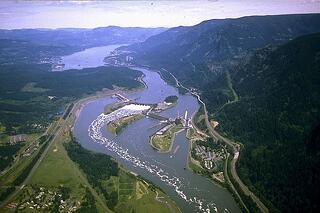 Yesterday I made my weekly commute through the Columbia River Gorge. The Gorge is beautiful and impressive. Beautiful for its great canyons, mighty river, expanse of forests, and waterfalls. Impressive because of the hydroelectric dams, wind generation, highway, river and rail transportation systems.
Yesterday I made my weekly commute through the Columbia River Gorge. The Gorge is beautiful and impressive. Beautiful for its great canyons, mighty river, expanse of forests, and waterfalls. Impressive because of the hydroelectric dams, wind generation, highway, river and rail transportation systems.
I've made this trip along the Washington/Oregon border so many times that the enormity of it often passes unnoticed. Perhaps most dramatic, the Bonneville Dam, sits in an amazing setting of cliffs, trees, and river pools. Built in 1929, this Dam provides 1,000 MW of renewable energy to the Pacific Northwest and beyond. The dam is also skirted by the impressive Historic Columbia River Highway and newer Interstate 84.
Its an extraordinary place; a balance of both conservation and development. Conservation of a canyon carved 15 million years ago by the Missoula Floods, and development from our grandparent's time; engineered projects of tremendous vision and investment. The Columbia's system of dams won world wars, fed nations, spawned industry, and powered the West. Today, the Gorge section of the Columbia River is also one of the great transportation corridors of the United States.
The stunning achievements I see both inspire and trouble me. In the first half of the past century, huge investments were made across our country--wisely--to build the most efficient infrastructure systems on the planet. The greatest generation gave us a national transportation system to support the efficient movement of people and goods. They gave us abundant energy and pioneered methods to transmit it to industry and home. They provided consistent clean water, improved sanitation, and perfected agriculture. These disciplined men and women understood the benefit of delayed gratification. Our departure from this heritage undermines the very foundation that has made our country great.
Two generations later, with our supposed wealth and savvy, we've done little to build upon what they left. Many structures built in the 40's, 50's, and 60's have reached their design-life (usually around 50 years) and are falling into disrepair. Despite our industry's pleading (see American Society of Civil Engineers Report Card), political leaders are starving the less-sexy problem of our national infrastructure.
It will require significant sacrifice to leave this place better than we received it. At a minimum, we have a responsibility to maintain that which was given us. The speed at which we are approaching the design life of our existing infrastructure systems is alarming. Without proper maintenance the outcome is eminent: failure. Unfortunately, the estimated cost to maintain our current systems is a minimum annual investment of some $454 billion*. It's humbling to consider the magnitude of this burden and sobering to recognize the inadequacy of my generation's contributions. An anemic investment that will become yet another deficit passed on to my children.
There are no easy answers, which is probably why politicians steer clear of this issue. A healthy program of infrastructure investment will require a commitment of public funds, a robust economy, and much-needed private investment. The infrastructure investment booms of the 60's and late 90's are evidence of a robust economy's power to support both private and public investment. As measured by percentage of GDP; China, India, and other countries are making annual investments several times that of our own**.
As professionals involved in the design, construction, and operation of our nation's infrastructure, we have a unique opportunity and responsibility to lead the national discourse on this important issue. We also must recognize that we share part of the responsibility for past mistakes. In particular, we've often encouraged an unbalanced focus on new construction instead of vital maintenance.
One of the focuses of our blog, Constructive Candor, is to raise the public's awareness of the importance of infrastructure investment. If this post resonates with you, we'd encourage you to take some action. Perhaps you could:
- Share your thoughts on this subject within your social networks. You can do this easily by clicking one of the social share buttons at the top of the page.
- The ASCE report card for your State might also be informative. Share your State's Report Card Here.
- Our friends who manage local cities, counties, utilities, and ports have a unique ability to address this issue. Discuss within your organization ways you can promote the importance of community infrastructure. Not sure how to do this? We'd love to work with you as a partner to help you communicate the importance of your agency's infrastructure systems.
- Subscribe to our blog to receive future blog posts on infrastructure advocacy.
- Share your thoughts in the comment section below on how we might best effect change. We are eager to start a conversation.
**The Economist "Life in the Slow Lane"
Photo Credit: Wikimedia Commons

